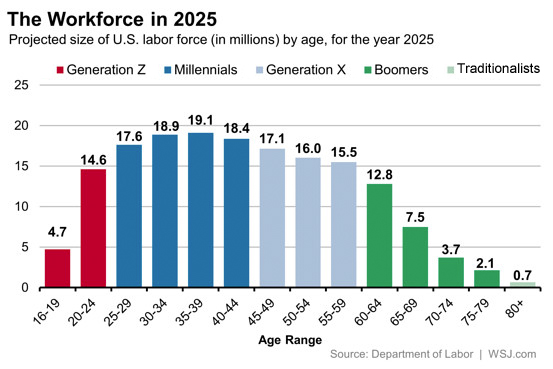
This blog is the part of an ongoing bi-monthly series titled Building Great Organizations that highlights best practices and tools to promote highly innovative, productive, and positive workplace culture. Written by Anne Partington.
Did you know that five generations are actively working today? What does that mean in the workplace and what are some ways to optimize and leverage the talents of employees across generations?

Generational diversity refers to having employees of various generations represented in the workplace.
The We ARE Livingston event series (sponsored by the Howell Area Chamber of Commerce) welcomed speaker Dr. Regina Banks-Hall, interim dean of Cleary University, to present Generational Characteristics: Bridging the Gap in the 21st Century.
Professor Banks-Hall guided the audience through a topic that is relevant to any employer in any industry as many organizations today have five generations of employees working together.
The current workforce has five generations in the workforce:
- Traditionalists: Born before 1945
- The Baby Boomers: Born between 1946 to 1964
- Generation X: Born 1965 to 1980
- Millennials: Born 1981 to 1999
- Generation Z: Born after 2000
Being aware of these generations, preferred styles of communication, and leveraging skills can prove to be a great asset in building effective organizations. Dr. Banks-Hall highlighted some key benefits of having generational diversity including greater skillsets for problem-solving, understanding different audience perspectives, learning opportunities to teach one another such as with tech applications, and mentoring as a tool to share experiences and aid in succession planning.
Looking ahead to the future, this Workforce in 2025 chart illustrates the strong presence from five generations in the workplace making planning strategies being even more important to drive effective communication and an inclusive work environment.

Actionable Strategies
Some strategies Dr. Banks-Hall shared to aid in successfully leveraging generational diversity are:
1. Eliminate stereotypes tied to any generation
- Avoid making assumptions
- Get to know your employees as individuals
- Value each employee for their unique skillset and what they bring to the table
2. Change your communication style to adapt
- Be open to using various communication channels
- Be aware that employees may have different preferred modes of communication
- Use different modes of communication including face to face conversations, web meetings, blogs, video conferencing, etc.
3. Utilize generationally diverse teams to leverage learnings/skills
- Encourage diverse teams to drive collaboration and build relationships
- Use experiences to drive strategies and innovation
Additional Reading
Defining Generations: Where Millennials End and Generation Z Begins
by Michael Dimock, President of Pew Research Center
Harnessing the Power of a Multigenerational Workforce
Created for the SHRM Foundation by BullsEye Resources